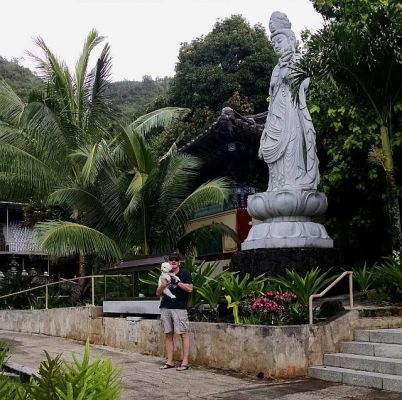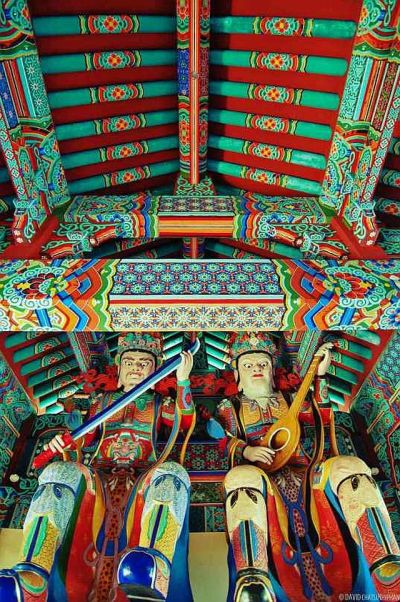I told the Alpha Japanese Female (AJF) that Max and I were going to visit Mu Ryang Sa. She responded, “Huh?”
That is pretty much the reaction you will get from many folks on Oahu when you mention the name of the largest Korean Buddhist temple outside of Korea. It’s just not that well known.
Despite its relative obscurity, Mu Ryang Sa (the name means “Broken Ridge Temple”) is a fascinating place. It’s found at the end of a narrow, winding road that penetrates deep into Palolo Valley just a few miles from Waikiki Beach.
Even the derivation of the name is interesting. It is called Broken Ridge Temple in part because the Honolulu City Council denied a request by the temple builders to exempt it from the height restrictions in the building code.

Notice how the roof was cut from a peak to a flat surface which may have ticked off a lot of monks but, of course, being monks they would never show it.
As a result, the contractors had to cut off the peaked portion of the temple roof.
The resultant “broken ridge” is a sore spot for the temple monks but they have turned Buddhist lemons into theological lemonade and point to the construction debacle as a learning lesson proving that all in life is an illusion and that “ignorance should be ignored.” (a shot across the City Planning Department’s bow, methinks.)

The Malt had a special affection for this statue which I think is the Goddess of Mercy. Max apparently equates mercy with treats.
Mu Ryang Sa is not an ancient worshipping place. It looks old because of its traditional architecture, designs and ornamentations. Whilst Mu Ryang Sa holds replicas of pagodas and statues dating to the 5th century, the temple actually started construction in 1980.
It is more than just a lovely place for the monks to hang out, chant and meditate. The temple is also a cultural community center with educational, cultural and monastic programs.
For three bucks (less for seniors – cough – and students) anyone can visit the temple and explore the grounds and even enter some of the buildings. Dogs, Maltese for example, are prohibited and therefore must be smuggled on to the temple grounds.
Long term, Mu Ryang Sa hopes to launch a four-year college that is devoted to Buddhist studies in English.
The school wants to focus on Korean Buddhism, language and culture including Korean dance, music, calligraphy and tea ceremony. The marketability of a degree in tea ceremony is left open to debate.

The temple gardens are both lovely and peaceful and, according to a certain Malt, they smell good, too.
The temple founders also want to establish a nursing home and hospice care facility for Korean elderly.
There is much to see at Mu Ryang Sa starting with an impressive entryway where giant statues of the “Four Heavenly Kings” guard each of the cardinal compass points and prevent the evil spirits from entering. According to legend, they sit up high and use their feet to squish the bad guys.

A cockroach-eye view of the Heavenly Kings keeping the riff-raff off the property. This photo by David Chatsuthiphan at http://www.unrealhawaii.com
A focal point of the property is the World Peace Pagoda. In the center of the pagoda’s base is a small urn, holding the remains of the Buddha. These came from a temple in Sri Lanka and are revered by believers as genuine relics of the historical Buddha.
The Bell Tower houses an impressive bronze bell that is a copy of the historical Emille Bell in Korea, the oldest Buddhist bell in Korea and the largest ringing bell in the world.
Dominating the temple grounds is the main building – the Hall of Heroes – which holds several manifestations of Buddha in a stylized Chinese setting which reminds visitors of the migration of the religion to Korea from China.
Statuary abounds. Some of the figures are on a grand scale and some are tiny and tucked away in the nooks and crannies of the temple grounds, for example, a crowd of 1080 miniature figurines of disciples.

There are (allegedly) 1080 of these little rascals located behind the Main Hall. They are said to represent faithful disciples.
There’s a lot more to see at Mu Ryang Sa and I’d recommend you click on the gorgeous photo site done by David Chatsuthipan. Like David, I do not pretend to fully understand what I am looking at when I visit there but my eyes gobble up the beauty nonetheless.
Max seemed to enjoy his visit. The selection of sniffing material was extensive and I’m pretty sure he got a small buzz from the incense. The AJF and I agreed to return again sans pooch to explore this hidden piece of Oahu at greater depth.
Categories: Max's Stories




Buddy The Maltese Dog, says: Wow Max, your so lucky to live around such interesting and beautiful history. I especially like the picture of you by the Goddess of Mercy and the picture at a pagoda. However, I find the picture of the pitched roof to be very interesting and I would hate to be bad, put on the edge of the roof for punishment or for doing something bad. That would scary me It was nice to hear from you again, I always look forward to your letters,
Fondly,
Buddy & Audrey
LikeLiked by 1 person
Always great to hear from Master Buddy and his Mom Audrey, one of the world’s greatest crochet artists! Buddy would have enjoyed a whole new world of smells.
LikeLike
BuddytheMalteseDog, Says:
HI Max, how did you know I am all for new smells. My nose is always where it shouldn’t be. Soon I’m going to be in jail also.
LikeLike
Beyond impressive and hard to believe it’s isn’t an antiquity-quite lovely! So does Max know the difference from Korean Buddhism and other ‘flavors’? I’d be curious of any differences. I’ll looking forward to your next outing sans pooch and all the wondrous sights you unearth. Thanks for sharing. David’s website is fantastic and oh-so colorful! 😉
LikeLiked by 2 people
Max is not much into Buddhism. I asked what the sound was of one paw clapping and he totally ignored me and walked away. He’s not a Zen dog.
LikeLiked by 1 person
One paw clapping? Fleas.
LikeLiked by 2 people
Given what we spend on that puplet, the fleas would be carrying Louis Vuitton bags and using their new iPhone6s.
LikeLiked by 2 people
Lady’s fleas are more your “flea market variety”. No matter how many eviction notices you serve up to the stallholders, they don’t “disappear”. Obviously, stronger language came to mind but am trying to put myself into any kind of vaguely Zen state after replacing the fridge and having a filling fall out just before school goes back and thoughts of severe infection invading my head.Appointment tomorrow.
LikeLike
I am impressed that Max has mastered the art of ‘looking away.’ Who is Max of which this man speaks? I am here for treats and incense, and wow! those Heavenly Kings!!
LikeLiked by 1 person
Max is working on his disappearing act so that he can be smuggled into more venues. I figured that if everything else failed, I could dress him as a very little monk and get him into Mu Ryang Sa.
LikeLiked by 1 person
All of us here can forget our internal squabbles and put our very small weights behind the monks over the bureaucrats. No contest. Case closed.
LikeLiked by 1 person
The dispute was a huge issue locally. It does seem kind of silly to cut off that one piece of roof just to comply with the codes but that’s the way the rules work and I guess the monks needed some better lobbyists.
LikeLike
Aren’t those colo(u)rs wonderful?
LikeLiked by 1 person
They are every bit as bright and striking in real life as they are portrayed by the camera. I believe there is some meaning behind the choice of those colo(u)rs but I’ll have to research that a bit as I cannot remember what the point was.
LikeLike
Given the strength of the Korean community I shouldn’t have been surprised at finding a temple there….but so huge a place!
Sounds as though the monks had not fully appreciated the importance of the ancient ceremony of presenting envelopes when seeking planning permission. It is an entrancing dance with much toing and froing…
Looks as though Max is enjoying his freedom after being banged up in high security for a while.
LikeLiked by 1 person
Indeed, the Korean community has become a major political, economic and social force in Hawaii. The neighborhood in which I live is predominantly Korean now; 20 years ago it was mostly Japanese and before that a mix of other ethnicities. The main drag through this part of town is Ke’eaumoku Street but it is now called Koreamoku Street.
Yes, Max was thrilled to be out and about but was worried that, if caught sneaking into the temple, he would face further incarceration. Recidivism is a terrible thing in a Malt. They turn mean, get tear drop tattoos under their eyes and start lifting weights in the exercise yard.
LikeLiked by 1 person
But did the treat for Max manifest themselves that’s the question?
LikeLiked by 1 person
Perhaps his prayers to the Goddess of Treats were successful because he did indeed get a tasty poi & chicken cookie upon his return home. It’s not entirely clear whether the treat was the result of divine intervention or the soft heart of the Alpha Japanese Female.
LikeLike
The heavenly kings and myriad little Buddhas give me the heebeejeebs, even more than knowing that you are a dog smuggler. Criminal or not, I did like this turn of phrase: turning Buddhist lemons into theological lemonade. I think I’d rather practice lemonade ceremony than tea ceremony.
LikeLiked by 1 person
Hey! Not just any dog smuggler, I happen to be a prolific and well known dog smuggler. And proud of it!
LikeLiked by 1 person
Peace, yes, Tom. Great shots.
LikeLike